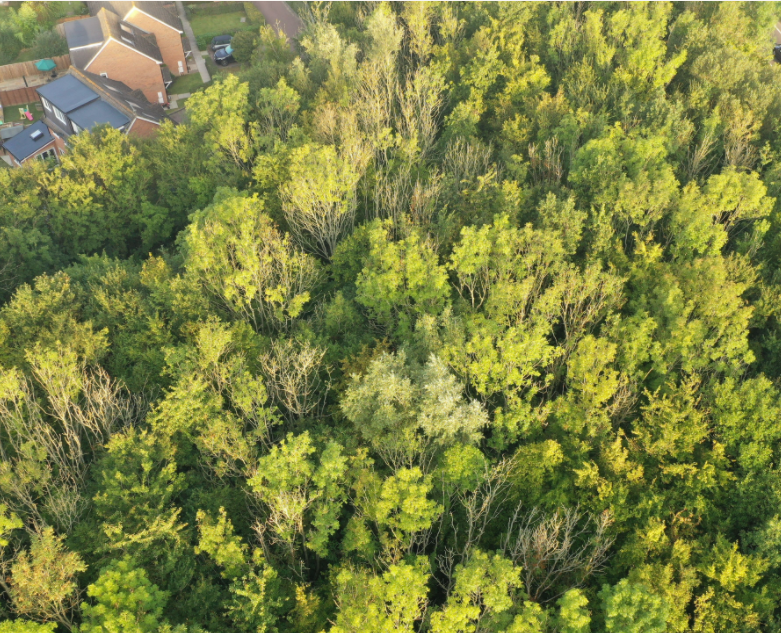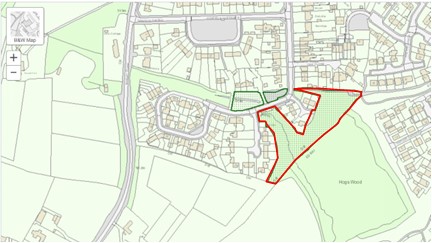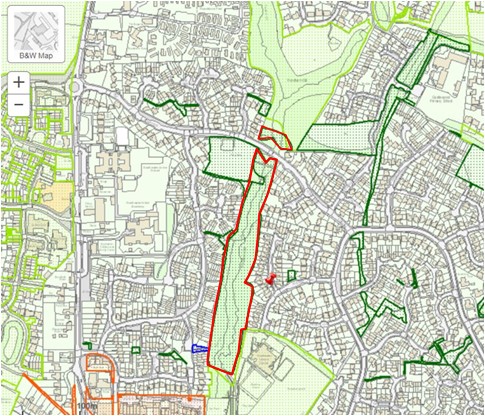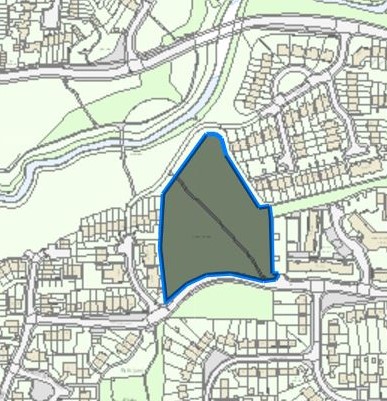Ash dieback
Ash dieback is a fungal disease that prevents ash trees from taking up water and minerals from their roots, causing leaf loss, dying branches and ultimately death. Infected trees become progressively fragile, often succumbing to secondary infections which have the ability to effect stability.
It is estimated that the disease will kill up to 90% of all ash trees in the UK, over the next decade. There is currently no cure or method of control to prevent or protect against it, which means trees that have succumbed to ash dieback must be felled. Some ash trees on Horsham District Council land have already been killed by the disease and have been felled in the past couple of years.
What ash dieback looks like
Ash trees that have become infected may display a range of symptoms but most obvious are dead twigs or branches with no leaves in the summer (June to September). The disease weakens the tree over time, with the canopy becoming thinner and thinner.
In this aerial shot of Horsham District Council land, the dying ash trees are clearly identifiable.

How we are tackling ash dieback on Horsham District Council land
There are thousands of ash trees on Horsham District Council land, both within woodland and parks and open spaces. More and more of these trees are showing the symptoms of ash dieback and the Council is working on a plan of action for the worst affected sites.
Starting in winter 2022 and for the following five years, we will be removing diseased and dying ash from many of our sites, including Warnham Local Nature Reserve and Southwater Country Park. This will be a phased approach, targeting woods in order of the urgency of the work.
Some of our woods are between 30-50% ash, so their removal will have a significant impact on the landscape, but this is unavoidable.
How we decide when to fell an infected tree
It is inevitable that we will need to fell infected trees on Council land that may cause harm to users of our sites, or to neighbouring property. We monitor trees on our land on a regular basis, with the interval between inspections dependent on the site location and history. We are trailing aerial survey using a drone, to inspect the canopy of seriously affected woodland areas from overhead.
We can track the progress of ash dieback in an individual tree by the loss of the canopy and amount of dead wood visible. We want to retain ash trees for as long as possible to see if they have natural resistance. However, once approximately 40% or more of the canopy has been lost, the tree is succumbing to ash dieback and will need to be felled. In some cases it will be necessary to fell a small number of healthy trees as part of the overall process to allow access into a wood, or to ensure dangerous trees can be felled safely. In some cases the trees will be left where they fall, in others the timber may be removed – it will depend on a site-by site basis.
Before we start work
Before we start felling works in a block of woodland we need to obtain a felling licence from the Forestry Commission, unless the trees are already dead or presenting a risk to persons or property.
Where a significant amount of felling is due to take place, we will contact residents who neighbour the land and provide more detailed plans for that site. Information notices will be put on-site, and we will update this webpage with as much information as possible. Please be aware, we will not be able to do this if we fell a single tree or a small clump.
Timescales and locations
We expect to be dealing with ash dieback for the next five years or so, as more trees become infected. We intend that most of the woodland felling should take place in the winters, but trees may be felled at any time during the year, if we believe there is a risk to public safety.
Work will start this winter 2021-22 with an area of woodland in North Horsham. Other areas with significant amounts of ash include Warnham Nature Reserve and Southwater Country Park.
Further information on ash dieback
In the majority of cases we will be relying on the process of natural regeneration to allow a wooded area to repair itself. This means saplings arising from the seedbank within the woodland’s soil. Some ash stumps may resprout, but this means that they were not entirely dead, rather than they were healthy and were felled by mistake.
Trees developing from natural regeneration are perfectly suited to their growing environment, establishing far more quickly and more successfully than larger trees which must be planted in and take some years to grow new roots and establish themselves properly. If there is a notable specimen ash tree in an open setting, we may consider replanting with another tree, but of a different species, not ash.
We will not be able to provide screening.
There are currently no treatments or methods of control. Up to 10% of ash trees are thought to have some natural immunity, but with only 1-2% being highly resistant to the disease. Once a tree starts showing signs of infection, the progression of the disease depends on the health of the individual tree, whether it suffers from other stresses, such as drought or pollution. This takes 2-4 years, on average, between the first visible signs of infection and a tree needing to be felled before it becomes unsafe.
As a general rule, large, mature trees seem to be able to survive for longer than younger trees, and trees in a rural woodland, with good growing conditions may have greater resilience than urban trees.
The microscopic spores of the fungus are carried for miles by the wind and infect the tree through its leaves.
We have a statutory duty of care to the public to maintain trees to ensure their safety. Whilst it will be upsetting to see any tree felled, let alone an area of woodland, we have no other choice but to carry out these operations.
Inevitably the loss of ash from our woodlands will impact on wildlife through loss of habitat and food. We will only be taking out ash that are definitely dying and minimise the impact to the wider woodland. Where safe to do so we will leave trunks to create standing dead wood habitat.
Current Projects
Rascals Close and Pond Farm Ghyll, Southwater
Ongoing ash dieback works are due to begin in Southwater in early January 2025.
This will include a secondary phase of work at the woodland adjoining Rascals Close and within the woodlands at Pond Farm Ghyll.
This work is expected to last approximately four weeks.
Whilst the work is on-going it may be necessary to restrict access to the woodland for health and safety reasons and there maybe some noise disruption.
Please follow all on-site signage and instruction during this time.

Rascals Close

Pond Farm Ghyll
Granary Way, Horsham
Further work is required to the woodland at Granary Way (within the shaded area shown). This will begin at in February 2025 with the removal of a small number of trees.
It has been identified that later in the year, a larger piece of work will be required at this site.
Further details on the scope and timescales of this project will be available soon.

Completed Ash dieback works
Since commencing our Ash dieback programme in 2022, work has been completed in the following locations;
- Granary Way, Horsham (Phase one)
- Bartholomew Way, Shottermill, Wordsworth Place and Chennells Brook Horsham
- Rascals Close, Southwater
- Bartholomew Way, North, Horsham
- Walnut Tree Plantation, Warnham Local Nature Reserve
- Benns Field, Southwater
